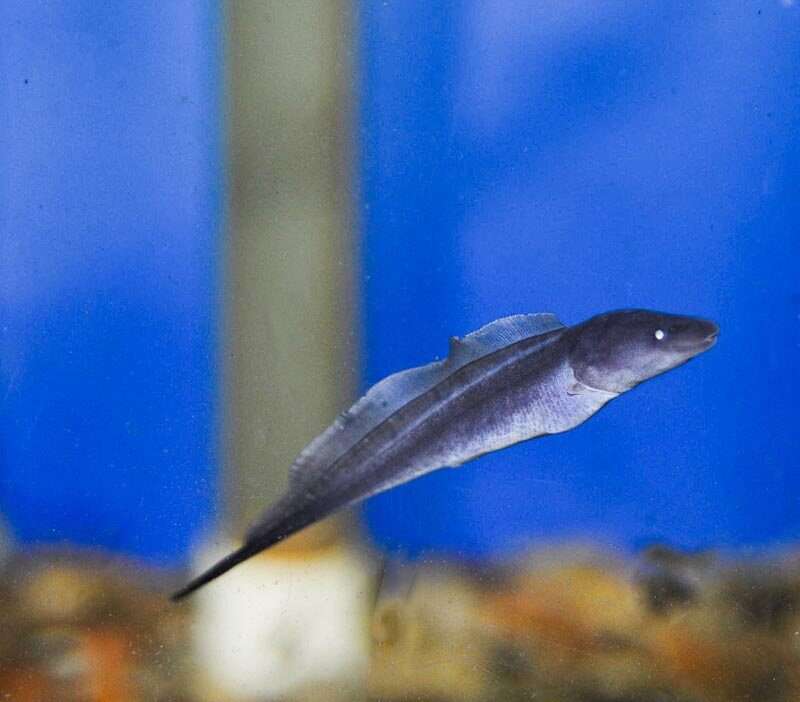
Size
These fish can grow to a maximum length of 5 1/2 feet (167 cm) and weigh 40 pounds (18.5 kg). Inches: 65.8 inches (167.01 cm).
Physical Characteristics
Even for a knife-type fish, the Aba Aba Knifefish is uncommon. It has a flat, long body that becomes somewhat cylindrical and more full near the head before coming to a thin point at the back. The loco-motional fin is not located on the belly as it is on other members of this group, but rather on the back. This fin has the ability to move backwards or forwards in an oblique manner. On the back and sides it is a dark bluish black colour, while on the underbelly it is silver to cream in colour. This fish possesses an organ that produces electricity that extends from the tip of its tail through the majority of its body, creating a very weak electric field. It can use this field to recognise items in the water, get a sense of its surroundings, navigate, and identify food, among other things. Males court ladies by using electric “stereotyped” communication.
Habitat
The Gymnarchus genus only contains only single species. In Africa, they can be found in the basins of the Nile, Niger, Volta, Chad, Senegal, and Gambia as well as Lake Rudolf. Aba Khife, Aba, Freshwater Rat-tail, Frankfish, and African knifefish are some of its other common names.
They typically inhabit marshes and swamps with thick vegetation and slowly moving streams. They hide out during the daytime in crevices or adjacent to the roots of aquatic vegetation. They will go to the inundated forests during the rainy season to breed, building enormous, floating nests that measure around 39 inches (1 m) in diameter. This fish consumes anything that falls into the water, including crustaceans, fish, insects, snails, frogs, and other fish.
In Captivity

- Foods and Feeding
The Aba Knife Fish are carnivores that consume snails, frogs, fish, insects, and crustaceans in their natural habitat. Although they will consume insects, prawns and crayfish in captivity, live feeder fish is the simplest thing to feed them. As opposed to feeding only live feeder fish, they can be trained to consume portions of dead, freshwater fish, which will help keep food costs down. Although it is unusual, some juvenile Abas have been seen to consume flake food.
- Aquarium Care
The Aba is a large, untidy fish that should ideally have a filter in the sump-pump form. To maintain this fish very content and healthy, a high-quality filter and 30 to 50% water changes are required each week, depending on the bio load. Because these fish have a history of attacking and hurting owners, proceed with extreme caution. To protect both yourself and your Aba from harm, make sure the lid is tight and secure.
Weekly water changes should be between 30% and 50%.
- Aquarium Setup
The Aba Knife Fish will spend the most of its time at or close to the tank’s bottom. This fish in the aquarium is really huge and destructive. The smallest recommended size is a 300 gallon tank. These big fish produce a lot of waste, thus a strong, effective filter is essential. Because they can damage almost any piece of equipment inside the tank, including filters and side-hanging heaters, an external sub-pump type filter is recommended. Add a powerful submergible heater to the tank’s bottom; the subpump also has a base-mounted heater.
To make this fish comfortable, the illumination in the tank should be very low. They prefer regions of the tank that are dimly illuminated, therefore it should be densely covered, ideally with big, twisted roots that provide cover. Make sure driftwood and other decorations are securely fastened in the tank if you intend to use them. For the protection of the fish and human fingers from harm, the tank must have a tight-fitting lid.
Minimum Tank Size: 300 gal (1,136 L) – A very large aquarium is required to keep adult Aba Knife Fish.
Suitable for Nano Tank: No
Substrate Type: Any
Lighting Needs: Low – subdued lighting
Temperature: 74.0 to 82.0° F (23.3 to 27.8° C)
Range ph: 6.5-8.0
Hardness Range: 10 – 25 dGH
Brackish: No
Water Movement: Weak
Water Region: Bottom – The Aba Knifefish will spend most of its time on or near the bottom of the tank.
Table





